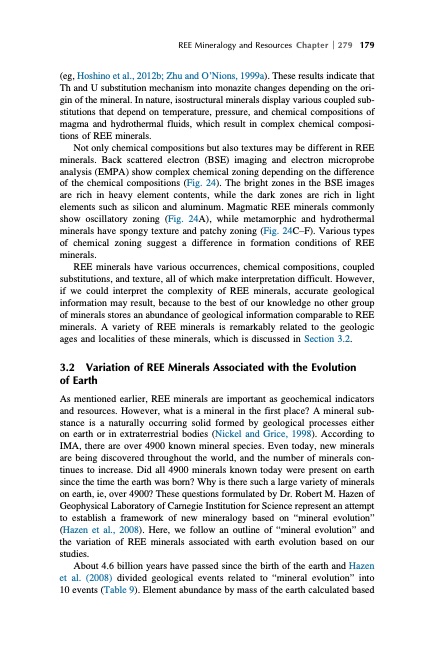
PDF Publication Title:
Text from PDF Page: 215
REE Mineralogy and Resources Chapter 279 179 (eg, Hoshino et al., 2012b; Zhu and O’Nions, 1999a). These results indicate that Th and U substitution mechanism into monazite changes depending on the ori- gin of the mineral. In nature, isostructural minerals display various coupled sub- stitutions that depend on temperature, pressure, and chemical compositions of magma and hydrothermal fluids, which result in complex chemical composi- tions of REE minerals. Not only chemical compositions but also textures may be different in REE minerals. Back scattered electron (BSE) imaging and electron microprobe analysis (EMPA) show complex chemical zoning depending on the difference of the chemical compositions (Fig. 24). The bright zones in the BSE images are rich in heavy element contents, while the dark zones are rich in light elements such as silicon and aluminum. Magmatic REE minerals commonly show oscillatory zoning (Fig. 24A), while metamorphic and hydrothermal minerals have spongy texture and patchy zoning (Fig. 24C–F). Various types of chemical zoning suggest a difference in formation conditions of REE minerals. REE minerals have various occurrences, chemical compositions, coupled substitutions, and texture, all of which make interpretation difficult. However, if we could interpret the complexity of REE minerals, accurate geological information may result, because to the best of our knowledge no other group of minerals stores an abundance of geological information comparable to REE minerals. A variety of REE minerals is remarkably related to the geologic ages and localities of these minerals, which is discussed in Section 3.2. 3.2 Variation of REE Minerals Associated with the Evolution of Earth As mentioned earlier, REE minerals are important as geochemical indicators and resources. However, what is a mineral in the first place? A mineral sub- stance is a naturally occurring solid formed by geological processes either on earth or in extraterrestrial bodies (Nickel and Grice, 1998). According to IMA, there are over 4900 known mineral species. Even today, new minerals are being discovered throughout the world, and the number of minerals con- tinues to increase. Did all 4900 minerals known today were present on earth since the time the earth was born? Why is there such a large variety of minerals on earth, ie, over 4900? These questions formulated by Dr. Robert M. Hazen of Geophysical Laboratory of Carnegie Institution for Science represent an attempt to establish a framework of new mineralogy based on “mineral evolution” (Hazen et al., 2008). Here, we follow an outline of “mineral evolution” and the variation of REE minerals associated with earth evolution based on our studies. About 4.6 billion years have passed since the birth of the earth and Hazen et al. (2008) divided geological events related to “mineral evolution” into 10 events (Table 9). Element abundance by mass of the earth calculated basedPDF Image | HANDBOOK ON THE PHYSICS AND CHEMISTRY OF RARE EARTHS

PDF Search Title:
HANDBOOK ON THE PHYSICS AND CHEMISTRY OF RARE EARTHSOriginal File Name Searched:
Chemistry-Rare-Earths-49.pdfDIY PDF Search: Google It | Yahoo | Bing
Sulfur Deposition on Carbon Nanofibers using Supercritical CO2 Sulfur Deposition on Carbon Nanofibers using Supercritical CO2. Gamma sulfur also known as mother of pearl sulfur and nacreous sulfur... More Info
CO2 Organic Rankine Cycle Experimenter Platform The supercritical CO2 phase change system is both a heat pump and organic rankine cycle which can be used for those purposes and as a supercritical extractor for advanced subcritical and supercritical extraction technology. Uses include producing nanoparticles, precious metal CO2 extraction, lithium battery recycling, and other applications... More Info
| CONTACT TEL: 608-238-6001 Email: greg@infinityturbine.com | RSS | AMP |